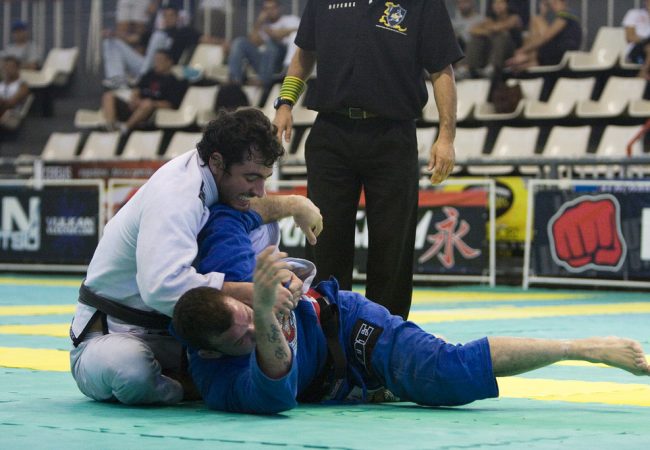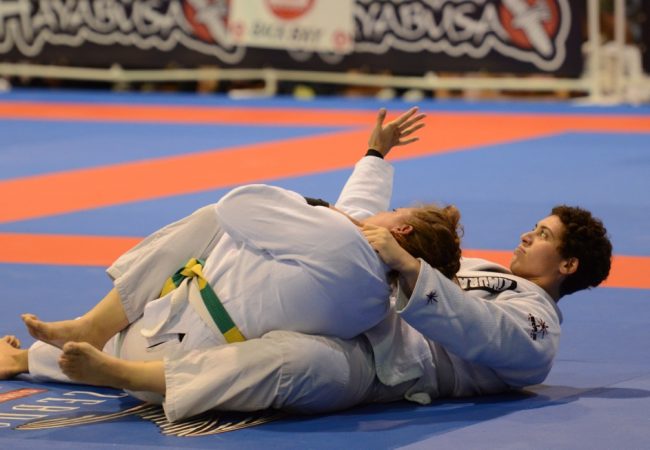
Anderson Silva training Jiu-Jitsu without his gi bottom with his former instructor Fábio Noguchi / Photo from book "Anderson Spider Silva"
I’ll admit, on encountering Anderson Silva at the airport, I didn’t think it would be easy. But I grabbed the dark cover with the UFC champion’s face on it, shelled out 24 reais at the cash register and started reading on the plane. It turned out to be an unforgettable flight.
I thought it unlikely that I’d find anything new about Anderson, after so many years following his career. I met the fighter just before Christmas of 2003 in the town Vitória da Conquista, in the Brazilian state of Bahia, in the days leading up to the event that would get his career back on track. We took a seat by the hotel pool and struck up a conversation about his departure from Chute Boxe team, his early days at soccer club Corinthians. And during the fight, against hometown fighter “Diamante Negro”, I’ll never forget the shock on press officer Fernando Flores’s face when he said, “Look at his footwork! This guy’s the best in the world, Dunlop. How can he be fighting here?”
In the book I revisited those leaner times. The really lean times are there too, in contrast to the plump ones of today. It’s no wonder Anderson broke into tears at least three times during the interview that gave origin to the book, penned by Eduardo Ohata. Here’s what I learned from the book about the champion’s life:
1. RESPECT THE MASTERS
Anderson wasn’t a student with many masters because he wanted to be, but because that’s what fate had in store for him. The proof of his respect for them comes in the opening lines, when he mentions all the trainers who brought him up: Leandro Frates, Kang, Edmar Cirilo dos Anjos, Cláudio Dalledone Jr., Fábio Noguchi, Almir Ramos, Diógenes, Gibi, Vitor Ribeiro, André Xaropinho, Rogério Camões, Edelson, Luis Dórea, Sérgio Cunha, Rodrigo Minotauro and Rogério Minotouro.
2. ANDERSON SILVA IN CARANDIRU PRISON
In journalism and in fighting, a professional who starts by throwing his most potent punch may surprise and win right off the bat. The book does a good job of that, opening with a little Anderson arriving at Carandiru, a penitentiary complex in São Paulo where sons cry and their mothers aren’t there to see. It was a chilly day, and Anderson was visiting his stepfather. He promised to never again set foot within those walls, to be an honest person. It wouldn’t be the first time the black belt derived something positive from such a dreadful moment.
(Watch Anderson on Globo channel last Sunday. “The fight [with Sonnen] will be sinister,” he promised.)
http://www.youtube.com/watch?v=fIPC6OrDCWI
3. KEEP AN OPEN MIND
Silva started out in capoeira, embraced taekwondo, learned to box, fell in love with Thai boxing and Jiu-Jitsu. He was never content to only master one aspect of the fight game. He opened his mind, and thanks to that he’s now seen as the best in the world.
4. LESSONS FOR ANYONE WHO FIGHTS IN THE STREET
The book stores two profound lessons for youths who get into street fights. The first, from his taekwondo teacher, a Korean named Kang: “Street fighting is for the weak. When someone gives you an undesirable present and you don’t take it, to whom goes the present? To him. Provocation is the same deal. Don’t accept it.” And the best one, from his uncle Benedito: “Anderson, if you get in a fight in the street I’ll stick you in the dog kennel.”
5. HOW TO DEAL WITH HATE AND RACISM
Anderson has taken a lot of hard knocks—outside the UFC, of course. He’s been socked in the gut by a prejudiced police man, insulted by a customer when he worked at McDonald’s, taken for a thief by his own teacher. Such episodes forged a man who has learned to turn the other cheek. That helps in, for instance, understanding his stance in the face of Chael Sonnen. His disinclination to exact retribution is apparent in his fight with Demian Maia—for which he feels remorse. “I was hateful towards Demian, lost focus and went overboard,” he explains in the book.
(Watch the cheerful side of the “Spider” on TV, hiding from Sabrina Sato and teaching how to do the triangle he used on Sonnen:)
http://www.youtube.com/watch?v=yi4gavwL5yU
6. URGE TO KILL
In the most powerful part, Anderson recalls the day he got slapped across the face by Rafael Cordeiro, now a coach on TUF Brazil, who demanded that he stop teaching Jiu-Jitsu at an upscale gym in the city. Anderson wasn’t even a blue belt, and feared he would be left without a job again, with children to feed. With a revolver given to him by a lowlife friend in his hand, Anderson made the decision that saved his life while sitting in a parked car in front of Chute Boxe academy. “I’m not going to do this. It’s not in my nature – I said, my head bowed down, and returned the weapon,” he says on the riveting page 66.
7. FINAL LESSON
I put down the book after Anderson’s final teaching—in fact, three lessons that were left for after the conclusion of the work.
1. It’s more important to produce good people than champions.
2. The most important thing in life is to become a person your children can be proud of.
3. Going through a rough spot? Always maintain your good cheer.
To me Anderson Silva’s jovial spirit throughout the course of his career is what’s most inspirational—and his greatest weapon. That must be why Chael Sonnen and his other rivals always resort to attacking his good cheer first. If Anderson doesn’t lose it, I feel they’ll just have to settle for second best.




